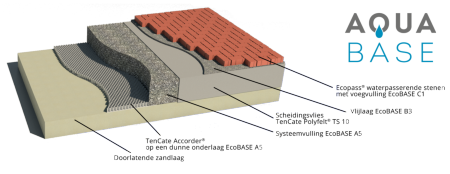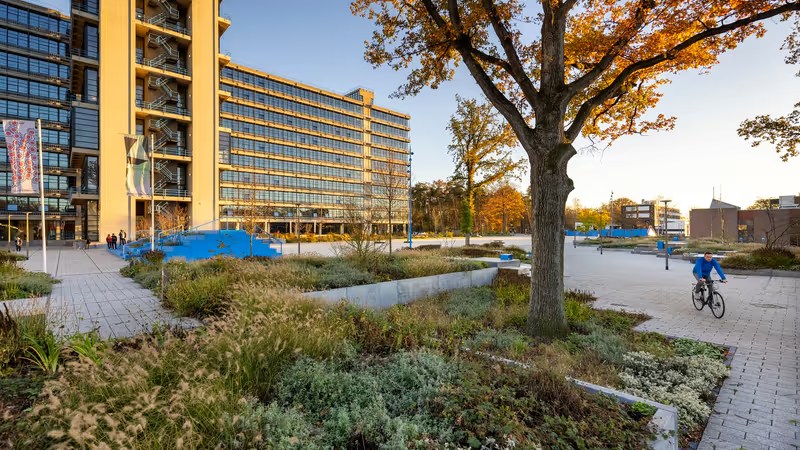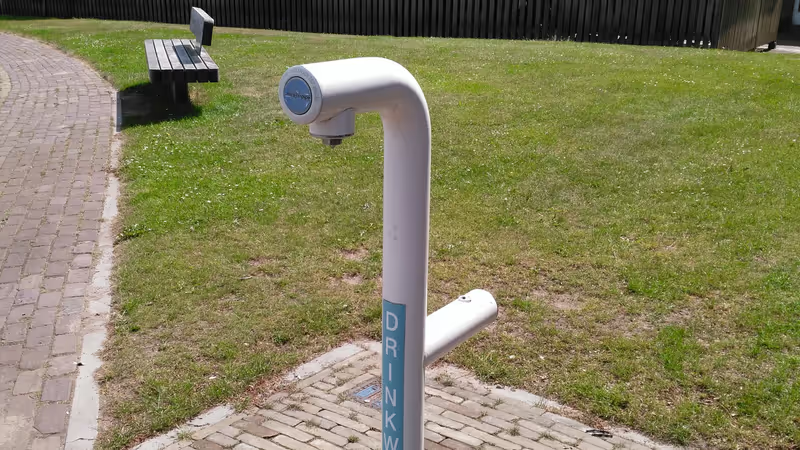Preserving the equilibrium
 Water is important: it’s important for you as a person, for nature and for the university, too. We believe it is important to treat water well in order to preserve the equilibrium of the ecosystem. At the University of Twente, we think about our consumption of drinking water as well as how we deal with rainwater and wastewater.
Water is important: it’s important for you as a person, for nature and for the university, too. We believe it is important to treat water well in order to preserve the equilibrium of the ecosystem. At the University of Twente, we think about our consumption of drinking water as well as how we deal with rainwater and wastewater.
Water at a glance
- Measures on campus facilitate the collection of rainwater and infiltration into the soil
- The UT encourages the use of tap water, as this prevents unnecessary plastic use
- The cold circulation system on campus contains more than 10 million litres of water
PLANNING
More about water
Rainwater on campus
Precipitation intensity is increasing, and the current water drainage system may not always be able to cope. The UT focuses on collecting rainwater and facilitating infiltration into the soil. Most drainpipes of the buildings are disconnected from the sewage system and the water flows into the ponds. Three brooks flow through the campus: the Roombeek, Bolhaarsbeek and Drienerbeek. These flow through several ponds that have an important function in the collection of rainwater, both for the UT and for the surrounding area. On top of that, the UT takes several measures to facilitate the processing of rainwater.
A meters-high milk cooling tank at the University of Twente does not store milk, but water. The tank, which has been in operation since 2023, is intended to lend a hand during heavy rainfall.
The rain barrel has a capacity of 35,000 liters and serves as a "buffer" for the sewer system in Enschede and the surrounding area. "Once in a while you have to deal with heavy rainfall, which leads to a lot of water on the streets because the sewer system cannot handle the water," said Richard Bults, creator of the smart rain barrel. The idea is to put together a network of smart rain barrels to create a buffer capacity in Enschede and surrounding municipalities.
However, the smart rain barrel does more than just collect water. Based on the weather forecast, this rain barrel can empty itself, so as not to overload the sewer system. The water can also be refreshed, and the stored water can be used to water surrounding vegetation and sports fields.
Water storage under De Boerderij car park  We have installed a water buffer and infiltration system with a hollow space under the car park of De Boerderij building (formerly the Faculty Club): AquaBASE. This water storage system was one of the first of its type in the Netherlands. The system consists of permeable stones interspaced with small joints to guarantee a good flow rate and infiltration capacity. The substrates feature hollow spaces, in which water is stored and have sufficient load-bearing capacity and stability to be used in car parks. This system retains water for longer, so that it infiltrates into the soil more slowly. For more technical information, visit the website of AquaBASE (Dutch only).
We have installed a water buffer and infiltration system with a hollow space under the car park of De Boerderij building (formerly the Faculty Club): AquaBASE. This water storage system was one of the first of its type in the Netherlands. The system consists of permeable stones interspaced with small joints to guarantee a good flow rate and infiltration capacity. The substrates feature hollow spaces, in which water is stored and have sufficient load-bearing capacity and stability to be used in car parks. This system retains water for longer, so that it infiltrates into the soil more slowly. For more technical information, visit the website of AquaBASE (Dutch only).
Gravel layer under car park 2 Underneath P2 is a thick layer of gravel which lets the soil retain more water, so that it can infiltrate deeper into the soil at a lower pace.
Surface water used for Cooling Circle The cold circulation system of the UT consists of a large basin measuring 10 metres deep and 36 metres wide that holds 10 million litres of cold water, which is used during the day to cool the connected buildings and research equipment. The chillers mainly cool the water at night, because the water temperature is naturally colder then, which saves a lot of energy. On top of that, it also saves costs, because the night rate for energy is lower than the day rate. The cool nighttime climate and air-cooled chillers join forces to cool the water down to approximately 8 to 10 degrees Celsius. For more information, visit the page on ‘Energy’.
Water lab & clear water storage basement On the Hogekampplein, there there is a water purification lab that is used for research from UT's membrane cluster, as well as filtering rainwater. Water is filtered to drinking water quality (although it cannot be used for that purpose as it would need certifications). The filtered water is then stored in the 'reinwaterkelder', or clear water storage basement, under the athletics track. It can be used for irrigation of the nearby sports fields. Even artificial pitches need to be watered quite frequently to keep them usable. Using rainwater for this is ideal, as we want to stop using tap water for that purpose. The rainwater needs to be filtered before it can be used, as rainwater has impurities causing algae growth. By filtering this pond water, around 1500-1600m3 of drinking water has been saved. Further insight can be gained by checking out the Energy Data Platform.
12 times greener: Enschede Watch this informative video on the topic (in Dutch):
Infiltration crates at Langezijds At Langezijds, infiltration crates of 25m3 per garden store rainwater. This is used for drip irrigation. There is surplus storage, from which plants can be watered that are present elsewhere in the building.
A retention pond is a pond which collects the overflow of the Roombeek and lets the water slowly infiltrate to replenish the groundwater table. This water can also be used in the terrain management to water sensitive plants and trees. The banks of the Roombeek behind Zilverling have a section where they are a little lower. When the Roombeek is transporting water after heavy rainfall, the water will flow over at this section to the retention pond and reduce the water flow in the Roombeek. All this contributes to reduced flood risk. 
Reducing the use of drinking water
The University of Twente takes measures to reduce the use of drinking water. The goal is to become a water neutral campus in 2030.
Rainwater to flush toilets In the Technohal building, collected rainwater is used to flush toilets. The rainwater is stored in a 20m3 tank adjacent to the building. The softened water that is used 1000 hours a year for misting over condensers is also reused for flushing the toilets.
In the Sports centre, Paviljoen and the ground floor of Zilverling, all urinals are waterless.
Many water taps in toilets are equipped with a sensor: on use, the tap runs for 6 seconds. This is shorter than the average user would leave the tap on, resulting in savings of 3,000l/day.
Join the Pipe water points The UT encourages the use of tap water, as this prevents unnecessary plastic use. Several outdoor Join the Pipe water points can be found on campus: on the O&O square, at the athletics track and at the multi-field. Inside, you can refill a bottle in the toilets or at one of the coffee machines. Join The Pipe uses the income generated by these points to fund clean drinking water projects in developing countries. The less plastic bottles we use, the less plastic bottles will have to be transported. For more information, visit Join the Pipe’s website.
Wastewater
The wastewater passes through the pumping station on the UT campus to the Water Board’s water treatment plant in Enschede. The Vechtstromen Water Board (Dutch only) is responsible for treating the wastewater, after which it flows to Kristalbad (Dutch only). The Vechtstromen Water Board also monitors the wastewater at the UT, taking quarterly samples from the UT’s pumping station, which are then tested at a laboratory. On top of that, the amount of wastewater, the flow rate, is recorded and the concentration levels of heavy metals and oxygen-binding susbtances in the wastewater are measured. These parameters are used to determine the number of pollution units on which the levy charged to the UT is based (Water Boards Act (Dutch only)).
There are strict procedures in place in laboratories to limit the concentration levels of chemicals in wastewater. Used glassware is rinsed 3 times with a small amount of water, as 3 rinses with a small amount are considerably more effective and environmentally friendly than a single rinse with more water. Chemical concentration levels will still be too high in the water used for the first 2 rinses, and this water must be collected and disposed of as hazardous waste. When cleaning chemically contaminated glassware, only the water used for the 3rd rinse can be flushed down the sewer.
What can you do to help?
- Cut a minute off your showers.
- Use a water-saving tap and shower head.
- Close the tap as quickly as possible.
- Do not use the toilet as a bin: contact lenses, tampons and deep-frying fat don't belong there.
- Drink tap water instead of bottled water
- Use rainwater, connect a rain barrel. Lime-free water is also better for your plants.
 Water is important: it’s important for you as a person, for nature and for the university, too. We believe it is important to treat water well in order to preserve the equilibrium of the ecosystem. At the University of Twente, we think about our consumption of drinking water as well as how we deal with rainwater and wastewater.
Water is important: it’s important for you as a person, for nature and for the university, too. We believe it is important to treat water well in order to preserve the equilibrium of the ecosystem. At the University of Twente, we think about our consumption of drinking water as well as how we deal with rainwater and wastewater.



 We have installed a water buffer and infiltration system with a hollow space under the car park of De Boerderij building (formerly the Faculty Club): AquaBASE. This water storage system was one of the first of its type in the Netherlands. The system consists of permeable stones interspaced with small joints to guarantee a good flow rate and infiltration capacity. The substrates feature hollow spaces, in which water is stored and have sufficient load-bearing capacity and stability to be used in car parks. This system retains water for longer, so that it infiltrates into the soil more slowly. For more technical information, visit the website of
We have installed a water buffer and infiltration system with a hollow space under the car park of De Boerderij building (formerly the Faculty Club): AquaBASE. This water storage system was one of the first of its type in the Netherlands. The system consists of permeable stones interspaced with small joints to guarantee a good flow rate and infiltration capacity. The substrates feature hollow spaces, in which water is stored and have sufficient load-bearing capacity and stability to be used in car parks. This system retains water for longer, so that it infiltrates into the soil more slowly. For more technical information, visit the website of 

